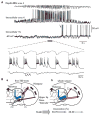A brief history on the oscillating roles of thalamus and cortex in absence seizures
- PMID: 22360294
- PMCID: PMC4878899
- DOI: 10.1111/j.1528-1167.2012.03421.x
A brief history on the oscillating roles of thalamus and cortex in absence seizures
Abstract
This review summarizes the findings obtained over the past 70 years on the fundamental mechanisms underlying generalized spike-wave (SW) discharges associated with absence seizures. Thalamus and cerebral cortex are the brain areas that have attracted most of the attention from both clinical and experimental researchers. However, these studies have often favored either one or the other structure in playing a major role, thus leading to conflicting interpretations. Beginning with Jasper and Penfield's topistic view of absence seizures as the result of abnormal functions in the so-called centrencephalon, we witness the naissance of a broader concept that considered both thalamus and cortex as equal players in the process of SW discharge generation. Furthermore, we discuss how recent studies have identified fine changes in cortical and thalamic excitability that may account for the expression of absence seizures in naturally occurring genetic rodent models and knockout mice. The end of this fascinating tale is presumably far from being written. However, I can confidently conclude that in the unfolding of this "novel," we have discovered several molecular, cellular, and pharmacologic mechanisms that govern forebrain excitability, and thus consciousness, during the awake state and sleep.
Wiley Periodicals, Inc. © 2012 International League Against Epilepsy.
Conflict of interest statement
I have no conflict of interest to disclose. I also confirm that I have read the Journal’s position on issues involved in ethical publication and I affirm that this report is consistent with those guidelines.
Figures




References
-
- Avanzini G, Vergnes M, Spreafico R, Marescaux C. Calcium-dependent regulation of genetically determined spike and waves by the reticular thalamic nucleus of rats. Epilepsia. 1993;34:1–7. - PubMed
-
- Bancaud J, Talairach J, Morel P, Bresson M, Bonis A, Geier S, Hemon E, Buser P. “Generalized” epileptic seizures elicited by electrical stimulation of the frontal lobe in man. Electroencephalogr Clin Neurophysiol. 1974;37:275–282. - PubMed
Publication types
MeSH terms
Grants and funding
LinkOut - more resources
Full Text Sources
Miscellaneous

